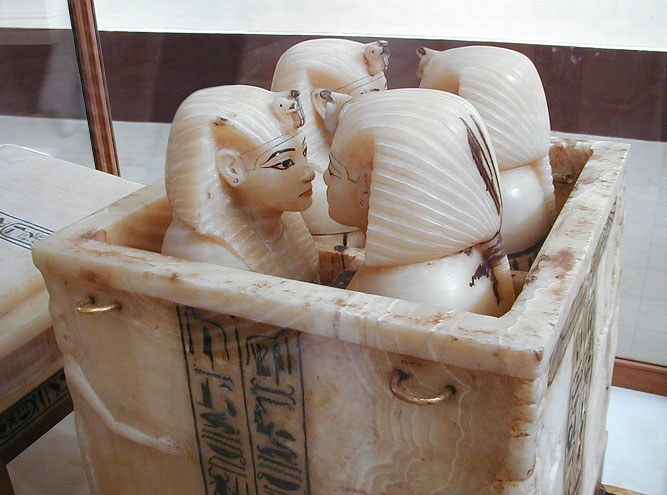Canopic chest on:
[Wikipedia]
[Google]
[Amazon]
 Canopic chests are cases used by
Canopic chests are cases used by
 Canopic chests are cases used by
Canopic chests are cases used by ancient Egyptians
Ancient Egypt () was a cradle of civilization concentrated along the lower reaches of the Nile River in Northeast Africa. It emerged from prehistoric Egypt around 3150BC (according to conventional Egyptian chronology), when Upper and Lower ...
to contain the internal organs removed during the process of mummification
A mummy is a dead human or an animal whose soft tissues and organs have been preserved by either intentional or accidental exposure to chemicals, extreme cold, very low humidity, or lack of air, so that the recovered body does not decay furt ...
. Once canopic jars began to be used in the late Fourth Dynasty, the jars were placed within canopic chests. Although the first proven canopic burials date from the Fourth Dynasty reign of Sneferu
Sneferu or Soris (c. 2600 BC) was an ancient Egyptian monarch and the first pharaoh of the Fourth Dynasty of Egypt, during the earlier half of the Old Kingdom period (26th century BC). He introduced major innovations in the design and constructio ...
, there is evidence to suggest that there were canopic installations at Saqqara
Saqqara ( : saqqāra ), also spelled Sakkara or Saccara in English , is an Egyptian village in the markaz (county) of Badrashin in the Giza Governorate, that contains ancient burial grounds of Egyptian royalty, serving as the necropolis for ...
dating from the Second Dynasty.Dodson, Aidan, "Canopic Jars and Chests", in Redford, Donald B. (ed) (2001). ''The Oxford Encyclopedia of Ancient Egypt'', vol. II, Oxford University Press. pp. 231–235
Connections to Ancient Egyptian culture
Canopic chests had an important place in Egyptian culture. Canopic chests contained the internal organs (viscera
In a multicellular organism, an organ is a collection of tissues joined in a structural unit to serve a common function. In the hierarchy of life, an organ lies between tissue and an organ system. Tissues are formed from same type cells to a ...
) of mummies, so they relate to the Egyptian belief that the afterlife is just as important as life on earth. Egyptians believed that everything had to be perfectly preserved to journey into the land after life and as part of the mummification process they removed viscera from the body.
Changes through history
The first canopic chests were simple and wooden, but as time went on they became more elaborate. Then, around the 21st Dynasty (1069–945 BCE), the Egyptians decided to leave the viscera inside mummies. But because they had been using canopic chests for thousands of years they kept putting them in tombs, just without anything in them. Canopic chests fell out of use during thePtolemaic Kingdom
The Ptolemaic Kingdom (; , ) or Ptolemaic Empire was an ancient Greek polity based in Ancient Egypt, Egypt during the Hellenistic period. It was founded in 305 BC by the Ancient Macedonians, Macedonian Greek general Ptolemy I Soter, a Diadochi, ...
.
Style and materials
The style and materials were different at different times, though always reflected the Egyptian ideal of perfectly measured and precise beauty.Ptolemaic period
The tall wooden shrine-like chests had bright painting on their sides and a falcon crouching on top. Craftsmen coated the wood withgesso
A restored gesso panel representing St. Martin of Tours, from St. Michael and All Angels Church, Lyndhurst, Hampshire
Gesso (; 'chalk', from the , from ), also known as "glue gesso" or "Italian gesso", is a white paint mixture used to coat rigi ...
to prepare it for the pigment they later painted it with. All the decoration tells us something about ancient Egyptian religion
Ancient Egyptian religion was a complex system of Polytheism, polytheistic beliefs and rituals that formed an integral part of ancient Egyptian culture. It centered on the Egyptians' interactions with Ancient Egyptian deities, many deities belie ...
. The falcon on top represents Sokar
Sokar (; also spelled Seker, and in Ancient Greek language, Greek, Sokaris or Socharis) is a hawk or falcon god of the Memphis, Egypt, Memphite necropolis in the Ancient Egyptian religion, who was known as a patron of the living, as well as a go ...
, a funerary god and picture on the sides show the chest’s owner worshipping Osiris
Osiris (, from Egyptian ''wikt:wsjr, wsjr'') was the ancient Egyptian deities, god of fertility, agriculture, the Ancient Egyptian religion#Afterlife, afterlife, the dead, resurrection, life, and vegetation in ancient Egyptian religion. He was ...
, god of the afterlife; Ra-Horakhty, a combination of the gods Horus
Horus (), also known as Heru, Har, Her, or Hor () in Egyptian language, Ancient Egyptian, is one of the most significant ancient Egyptian deities who served many functions, most notably as the god of kingship, healing, protection, the sun, and t ...
and Ra; four sons of Horus
The four sons of Horus were a group of four ancient Egyptian deities, deities in ancient Egyptian religion who were believed to protect deceased people in the ancient Egyptian afterlife beliefs, afterlife. Beginning in the First Intermediate Peri ...
, each of whom guards one of the viscera traditionally removed during mummification; the dyed pillar, which represents Osiris, and the tyet, which represents Isis
Isis was a major goddess in ancient Egyptian religion whose worship spread throughout the Greco-Roman world. Isis was first mentioned in the Old Kingdom () as one of the main characters of the Osiris myth, in which she resurrects her sla ...
. The painting is not as perfectly measured and precise as earlier Egyptian art, because Egyptian civilization was decaying when it was made.
References
Bibliography
* * *External links
{{DEFAULTSORT:Canopic Chest Canopic chests Egyptian artefact types